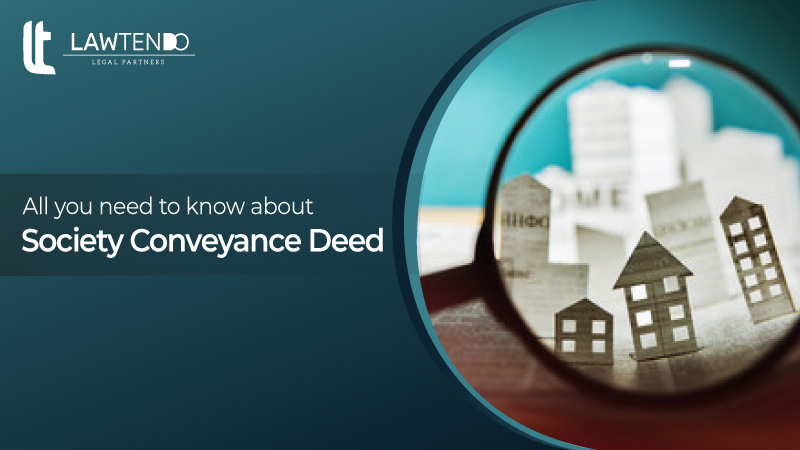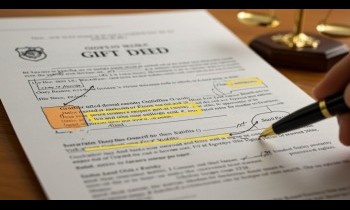Complete Guide on Society Conveyance Deed

Date : 22 Jul, 2021
Post By Bhupender Tanwar
The developer sells the flats to various buyers for a price after constructing a housing structure with a number of units, common areas, and other amenities (making a profit in the process). The purchasers acquire ownership of the individual units and have a shared right to use the communal amenities. The flat purchasers created a housing association after that. Subscriptions from members are collected on a regular basis by the housing society. The funds are used to maintain the common areas, provide common services (such as electricity backup and water supply), and engage maintenance and housekeeping personnel, among other things. The legal ownership of the common spaces of the housing society is conferred by having a Conveyance Deed, and it plays a vital role in proving legal ownership and subsequent renovation projects.
In Housing Societies, the Value of a Conveyance Deed: The original landowner's ownership is transferred to the developer first. The developer can now create a society on this site thanks to their recently acquired land rights. They begin construction while simultaneously marketing the yet-to-be-built civilization to potential customers. Those who agree to purchase the finished flats sign a contract with the buyer. This document may go by other names, such as "Sale Agreement" or "Purchase Agreement," but it is essentially the same. This agreement could contain a variety of clauses. The most essential of these usually stipulates that after the development is finished, the developer will hand over the flats to the owners. Consult the best lawyer online The developer then passes over the units to the buyers after the development is completed. There is, however, a catch. You have only taken ownership of your apartment as a buyer. The developer retains ownership of the entire parcel of land as well as all structures on it. Possessors have some rights, but they are limited when compared to owners. As a result, the developer has more rights to the land than you have and hence can continue to lord it over you in some ways. The developer must execute a Conveyance Deed to transfer the title of the entire parcel of land as well as the buildings on it to the respective buyers. A conveyance deed is a legal document that transfers ownership of a piece of real estate from one person to another. Flat and common area conveyance deeds must be executed by the developer to transfer ownership rights to the respective owners and the housing society. As a result, the purchasers will become the owners of their separate apartments, and all purchasers will become common owners with the right to utilize the common areas collectively.
The necessity of conveyance deed: Even if you own a flat, you do not own the land or the building. As a result, if the building collapses, you will need the permission of the builder or the landowner to rebuild it. Again, because he is the legal owner and holds the Title Deeds to the property, the builder/landlord may mortgage the property you acquired, i.e. land and building, unless you obtain land conveyance. If the building is later redeveloped or if the property contains some unutilized Floor Space Index, the builder/landlord may be able to claim the advantages (FSI). The builder/landlord may move the FSI/ TDR to his other projects and profit from it, robbing the flat purchasers/society of their legal rights. The builder/landlord may also sell all Development Rights and Legal Rights on the land to a third party, resulting in a third-party stake in the property. Society's rehabilitation has been hampered by a lack of transportation. As a result, the society must file a request with the Competent Authority to transfer ownership of the aforementioned land to them. How to Put a Conveyance Deed into Action: While completing each required Conveyance Deed, keep the following tips in mind: The parties must put it in writing and sign it. At least two independent witnesses are required to attest to it. It is necessary to pay the stamp duty. To ensure this, the Deed must be executed on non-judicial stamp paper with a value equal to the amount of stamp duty due It must be registered with the local Sub-Registrar of Assurances as a condition of doing business. It must explicitly describe the land and other properties being transferred, the parties' identities, the title history of the land and assets in question, and the fact that ownership rights are being transferred at the very least Conveyance Deed required Documents: The Conveyance Deed must be presented to the local Sub-Registrar of Assurances for registration after it has been properly executed and stamped. Some states may require the Conveyance Deed's drafter, an advocate or registered deed-writer, to sign a declaration and provide their registration number. Proof of payment, if any, of the registration costs due. Proofs of all parties' and attesting witnesses' identities and addresses What is Deemed Conveyance: Deemed Conveyance is the third and most popular method of obtaining a conveyance. When a builder/landowner of a building refuses to transfer land ownership to the society, the society can file a request with the Registrar of Co-operative Housing Societies to transfer ownership of the building and land to them. This is accomplished by Deemed Conveyance (DC), which transfers ownership of buildings and land to the society without requiring the builder/landowner to do so. Get in touch with the best lawyer online Advantages of Deemed Conveyance Obtaining legal title and ownership of land, as well as developing rights in the Society's name and filing the necessary paperwork with the government. The additional FSI is retained by society, and TDR is utilized. The land will be available for purchase and will be free of charge. The loans can be financed through mortgages. If the structure needs to be redeveloped at a later date due to age, earthquake, or any other reason, permission from the planning authorities may be required. All societal advantages accrue from business activities. For Instance: The Maharashtra government has eased the terms for obtaining a deemed conveyance (DC)-ownership right of plot certificate from a builder by reducing the number of documents required from 12 to 8, and stipulating that DC will be granted even if the society lacks an Occupation Certificate (OC) or a Building Completion Certificate (CC). Within four months of the housing society's founding, landowners or developers must transfer the title to the plot. In many situations, builders refuse to transfer property titles to housing societies in the hopes of gaining access to future floor space index (FSI) or advantages if the building is renovated.





